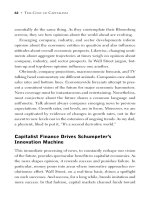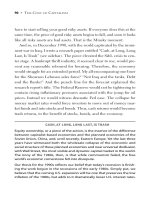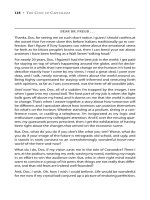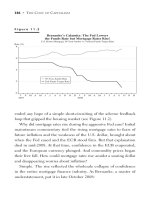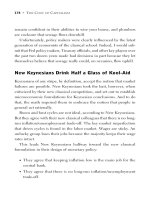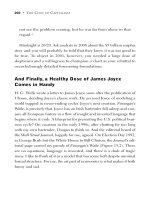FM11 Ch 09 The Cost of Capital
Bạn đang xem bản rút gọn của tài liệu. Xem và tải ngay bản đầy đủ của tài liệu tại đây (190.72 KB, 54 trang )
9 - 1
CHAPTER 9
The Cost of Capital
Cost of Capital Components
Debt
Preferred
Common Equity
WACC
9 - 2
What types of long-term capital do
firms use?
Long-term debt
Preferred stock
Common equity
9 - 3
Capital components are sources of
funding that come from investors.
Accounts payable, accruals, and
deferred taxes are not sources of
funding that come from investors, so
they are not included in the
calculation of the cost of capital.
We do adjust for these items when
calculating the cash flows of a
project, but not when calculating the
cost of capital.
9 - 4
Should we focus on before-tax or
after-tax capital costs?
Tax effects associated with financing can be
incorporated either in capital budgeting cash
flows or in cost of capital.
Most firms incorporate tax effects in the cost of
capital. Therefore, focus on after-tax costs.
Only cost of debt is affected.
9 - 5
Should we focus on historical
(embedded) costs or new (marginal)
costs?
The cost of capital is used primarily
to make decisions which involve
raising and investing new capital.
So, we should focus on marginal
costs.
9 - 6
Cost of Debt
Method 1: Ask an investment banker
what the coupon rate would be on
new debt.
Method 2: Find the bond rating for
the company and use the yield on
other bonds with a similar rating.
Method 3: Find the yield on the
company’s debt, if it has any.
9 - 7
A 15-year, 12% semiannual bond sells
for $1,153.72. What’s r
d
?
60 60 + 1,00060
0 1 2 30
i = ?
30 -1153.72 60 1000
5.0% x 2 = r
d
= 10%
N I/YR PV FVPMT
-1,153.72
INPUTS
OUTPUT
9 - 8
Component Cost of Debt
Interest is tax deductible, so the
after tax (AT) cost of debt is:
r
d AT
= r
d BT
(1 - T)
= 10%(1 - 0.40) = 6%.
Use nominal rate.
Flotation costs small, so ignore.
9 - 9
What’s the cost of preferred stock?
P
P
= $113.10; 10%Q; Par = $100; F = $2.
( )
%.0.9090.0
10.111$
10$
00.2$10.113$
100$ 1.0
===
−
=
n
ps
ps
P
D
r
=
Use this formula:
9 - 10
Picture of Preferred
2.50
2.50
0 1 2
r
ps
= ?
-111.1
∞
2.50
.
50.2$
10.111$
PerPer
Q
rr
D
==
%.9)4%(25.2 %;25.2
10.111$
50.2$
)(
====
NompsPer
rr
9 - 11
Note:
Flotation costs for preferred are
significant, so are reflected. Use
net price.
Preferred dividends are not
deductible, so no tax adjustment.
Just r
ps
.
Nominal r
ps
is used.
9 - 12
Is preferred stock more or less risky to
investors than debt?
More risky; company not required to
pay preferred dividend.
However, firms want to pay preferred
dividend. Otherwise, (1) cannot pay
common dividend, (2) difficult to
raise additional funds, and (3)
preferred stockholders may gain
control of firm.
9 - 13
Why is yield on preferred lower than r
d
?
Corporations own most preferred stock,
because 70% of preferred dividends are
nontaxable to corporations.
Therefore, preferred often has a lower
B-T yield than the B-T yield on debt.
The A-T yield to investors and A-T cost
to the issuer are higher on preferred
than on debt, which is consistent with
the higher risk of preferred.
9 - 14
Example:
r
ps
= 9% r
d
= 10% T = 40%
r
ps, AT
= r
ps
- r
ps
(1 - 0.7)(T)
= 9% - 9%(0.3)(0.4) = 7.92%
r
d, AT
= 10% - 10%(0.4) = 6.00%
A-T Risk Premium on Preferred = 1.92%
9 - 15
Directly, by issuing new shares of
common stock.
Indirectly, by reinvesting earnings
that are not paid out as dividends
(i.e., retaining earnings).
What are the two ways that companies
can raise common equity?
9 - 16
Earnings can be reinvested or paid
out as dividends.
Investors could buy other securities,
earn a return.
Thus, there is an opportunity cost if
earnings are reinvested.
Why is there a cost for reinvested
earnings?
9 - 17
Opportunity cost: The return
stockholders could earn on
alternative investments of equal
risk.
They could buy similar stocks
and earn r
s
, or company could
repurchase its own stock and
earn r
s
. So, r
s
, is the cost of
reinvested earnings and it is the
cost of equity.
9 - 18
Three ways to determine the
cost of equity, r
s
:
1. CAPM: r
s
= r
RF
+ (r
M
- r
RF
)b
= r
RF
+ (RP
M
)b.
2. DCF: r
s
= D
1
/P
0
+ g.
3. Own-Bond-Yield-Plus-Risk
Premium:
r
s
= r
d
+ Bond RP.
9 - 19
What’s the cost of equity
based on the CAPM?
r
RF
= 7%, RP
M
= 6%, b = 1.2.
r
s
= r
RF
+ (r
M
- r
RF
)b.
= 7.0% + (6.0%)1.2 = 14.2%.
9 - 20
Issues in Using CAPM
Most analysts use the rate on a long-
term (10 to 20 years) government
bond as an estimate of r
RF
. For a
current estimate, go to
www.bloomberg.com, select “U.S.
Treasuries” from the section on the
left under the heading “Market.”
More…
9 - 21
Issues in Using CAPM (Continued)
Most analysts use a rate of 5% to 6.5%
for the market risk premium (RP
M
)
Estimates of beta vary, and estimates
are “noisy” (they have a wide
confidence interval). For an estimate
of beta, go to www.bloomberg.com
and enter the ticker symbol for
STOCK QUOTES.
9 - 22
What’s the DCF cost of equity, r
s
?
Given: D
0
= $4.19;P
0
= $50; g = 5%.
( )
g
P
gD
g
P
D
r
s
+
+
=+=
0
0
0
1
1
( )
= +
= +
=
$4. .
$50
.
. .
.
19 105
0 05
0 088 0 05
13 8%.
9 - 23
Estimating the Growth Rate
Use the historical growth rate if you
believe the future will be like the
past.
Obtain analysts’ estimates: Value
Line, Zack’s, Yahoo!.Finance.
Use the earnings retention model,
illustrated on next slide.
9 - 24
Suppose the company has been
earning 15% on equity (ROE = 15%)
and retaining 35% (dividend payout
= 65%), and this situation is
expected to continue.
What’s the expected future g?
9 - 25
Retention growth rate:
g = ROE(Retention rate)
g = 0.35(15%) = 5.25%.
This is close to g = 5% given earlier.
Think of bank account paying 15%
with retention ratio = 0. What is g of
account balance? If retention ratio is
100%, what is g?




